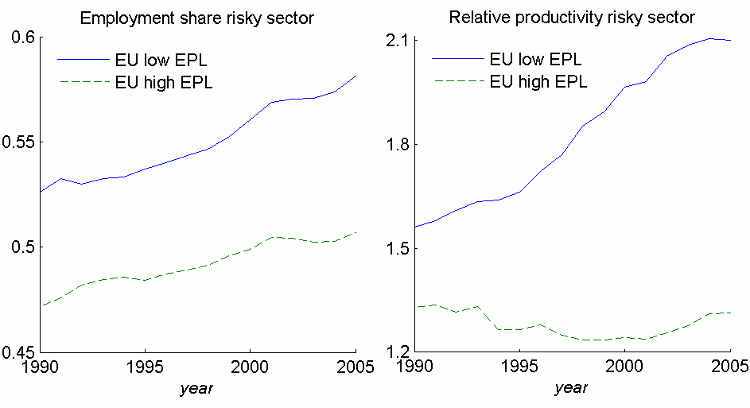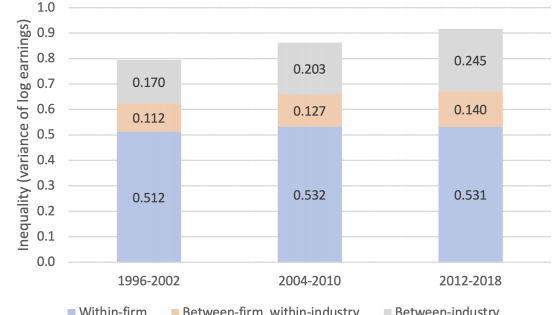Until the mid-1990s, EU productivity had been converging towards US productivity. But since then, US productivity growth has accelerated and the US-EU gap has widened. Cross-region comparisons, including van Ark et al. (2008), show that the production and use of information and communication technologies (ICT) are much lower in the EU than in the US and that this explains much of the relative slowdown.
Why has the adoption of the new ICT been much slower in the EU? Recent research in Brynjolfsson et al. (2008) and our latest paper (Bartelsman et al. 2010) provides evidence that the adoption of these new technologies is associated with an increase in the variance of firm productivity. For example, implementation of advanced business software like SAP and Oracle requires a new organisational structure and the outcome is inherently uncertain. The variance of firm productivity is therefore relatively large in sectors that intensively use ICT.
For a given firm, adopting a technology with risky outcomes is attractive because the benefits can be scaled up if the outcome is good, while firms can fire workers or exit if things go poorly. Essentially, the ability to close a production unit is a real option that bounds the downward risk.
The role of labour market policy
One major policy difference between Europe and the US is that employment protection legislation is much stricter in Europe (Nicoletti et al. 2000). Further, between European countries there is substantial variation in legislation.
We show that the employment share of risky (ICT-intensive) sectors is indeed smaller in the EU than in the US, and that, within Europe, high-protection countries have relatively smaller ICT-intensive sectors than low-protection countries. We then find that countries with strict legislation are relatively less productive. Those facts are depicted in Figure 1 and Figure 2 and are consistent with the story above that high-protection countries did not fully benefit from the new risky ICT opportunities that arose in the 1990s. Using a country-industry panel dataset (EUKLEMS), we find robust evidence that high-risk innovative sectors that intensively use ICT are relatively smaller in countries with stricter employment protection and that the effect of legislation on sectoral allocation increases with riskiness.
Figure 1. Sectoral allocation and productivity in the EU versus the US
Figure 2. Sectoral allocation and productivity in low-protection EU countries versus high-protection EU countries
In order to explore the mechanism and to establish how much of the US-EU productivity divergence can be explained by stricter employment legislation, we develop a two-sector matching model with endogenous technology choice, i.e. firms can choose between a safe sector with stable productivity and a risky sector with productivity subject to sizable shocks. In the absence of employment protection legislation, the risky sector is relatively attractive because firms have the option to fire workers which bounds the downward risk. Introducing legislation makes it less attractive to use risky technologies, so this establishes the negative relationship between employment protection and the size of the risky sector. Legislation also results in more labour hoarding, i.e. the productivity threshold below which a worker is fired is lower if legislation is stricter. Further, the size of the effect increases as the variance of the shocks in the risky sector increases. This explains why productivity growth is lower in high-protection countries in particular when new technologies with a high variance in profitability become available.
We calibrate the model using a variety of aggregate, industry, and micro-level data sources. We then simulate the model to reflect both the observed differences across countries in employment legislation and the observed increase in the variance of firm performance associated with the adoption of new ICT since the mid-nineties. The simulations produce a differential response to the arrival of risky technology between low and high-protection countries that coincides with the findings in the data. The described mechanism can explain a considerable portion of the slowdown in productivity in the EU relative to the US since the mid-nineties. Increasing employment protection in the US (around one month of production) to European levels (around seven months of production), reduces aggregate productivity by about 10%, partly through a direct reduction of average productivity within the risky sector and partly through a significant reduction of activity in the risky sector.
One of the simplifying assumptions that we make is that workers are risk neutral. A natural question to ask is whether employment protection is more desirable if workers are risk averse? This is not obvious since employment protection makes the unemployment state less attractive because it increases unemployment duration and risk averse workers prefer the differences between the good and bad state to be small. In other words, it puts the burden of unemployment on a smaller group. In richer models where optimal unemployment benefits and employment protection are determined jointly, optimal legislation may well be positive.
Regardless of your view of the origins of employment protection legislation, our research shows that a change over time in the type of technological opportunities available, such as using ICT in production chains, has increased the economic costs of employment protection while the benefits are not affected.
References
Bartelsman, Eric J, Pieter A Gautier, and Joris de Wind (2010), “Employment Protection, Technology Choice, and Worker Allocation”, CEPR Discussion Paper 7806.
Brynjolfsson, E, A McAfee, M Sorell, and F Zhu (2008), “Scale without mass: business process replication and industry dynamics”, Harvard Business School Working Paper, 07–016.
Nicoletti, G, S Scarpetta, and O Boylaud (2000), “Summary Indicators of Product Market Regulation with an Extension to Employment Protection Legislation”, Discussion paper, OECD, Economics Department.
Van Ark, B, M O'Mahony, and M Timmer (2008), “The productivity gap between Europe and the US: trends and causes”, Journal of Economic Perspectives, 22(1):25-44.





